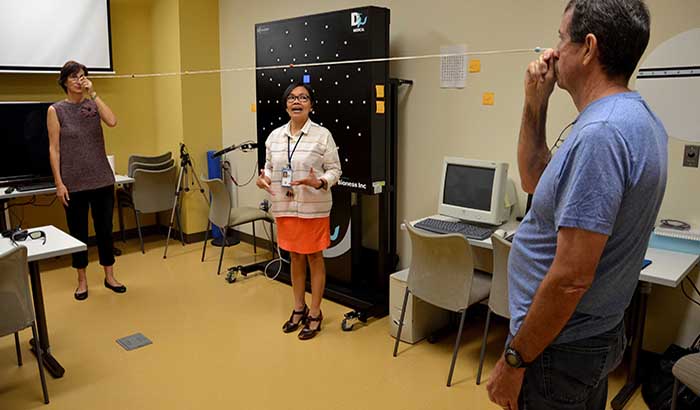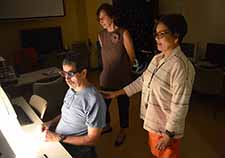Office of Research & Development |
 |


Jill Coulter (left) helps her husband, Joseph "Pepper" Coulter, with a rehabilitation exercise as occupational therapist Imelda Llanos offers instructions. As Jill calls out one of the colored beads on the rope, Pepper has to focus his sight on that bead. (Photo by Ed Drohan)
August 10, 2017
By Mike Richman
VA Research Communications

Joseph "Pepper" Coulter wears special goggles as he maneuvers two slides that make up a 3-D image until all of the image elements are aligned. Looking on are his wife, Jill (center), and occupational therapist Imelda Llanos. (Photo by Ed Drohan)
Joseph "Pepper" Coulter wasn't expected to live.
The Navy Veteran stood on a ladder while trimming a tree one summer day in 2010. But he lost his footing, fell nine feet, and landed on his head on pool pavers. The impact, believed to be on the right side of his head, threw his brain up against the left side of his skull.
Fortunately, his neighbor, who is a neurologist, came right away to help. Paramedics also arrived quickly and took him to an advanced trauma center about two miles away.
"I was told that if it were five miles away he wouldn't have made it," says his wife, Jill Coulter. "He had his skull evacuated. Most of the left side of his brain is scar tissue. Parts of the left frontal lobe have been removed. He was unresponsive for three weeks, and for part of the time they took him off medication because he was still in a coma-like state with a ventilator. The prospects were very, very grim. That's the best way to put it."
"Sometimes it helps them just to talk with a person that's actually been there."
Pepper Coulter had suffered a massive traumatic brain injury (TBI), the type that can kill or leave someone in a life-long vegetative state. But in what his wife calls "one of those rockin' miracles," he has rehabilitated himself through therapy and has recovered a good portion of his cognitive abilities. A year ago, he finished his first novel since the injury.
Now, the 61-year-old Vet is dedicating his time to a VA program that aims to improve the lives of Veterans who have suffered TBI by predicting outcomes. He and his wife are on an advisory panel to the VA TBI Model System. The initiative examines the recovery course of Veterans and active-duty military from the point of injury to post-rehabilitation, and tries to assess outcome measurements such as employment, supervision needs, and marital status. From a patient and caretaker perspective, the Coulters provide feedback to researchers and others on rehabilitation options, equipment and technologies, and the implementation of study procedures they feel would be effective, among other pertinent information.
"Essentially, they are part of the research team conducting the study," says Dr. Risa Nakase-Richardson, a clinical research neuropsychologist at the James A. Haley Veterans' Hospital in Tampa and an associate professor at the University of South Florida. "One of the ways the research community is improving the application of its findings to clinical care is by engaging stakeholders, including patients and family members, in the research process."

Richardson is the key scientific investigator for the VA TBI Model System. The initiative produces data that are intended to assist VA in planning for care and support of the many Veterans and families affected by TBI. Such information, she says, lays the foundation for literature on predicting outcomes for the Veteran community. She says clinicians will be better able to understand, for example, how long it will take Veterans to recover from a TBI, their likelihood of returning to work, and their chances for living independently.
"Those are the questions that people and families ask," she says. "Most of those questions would be answered with civilian-based studies. But we've discovered that civilian studies don't look like the kind of people we're treating in VA who have violent brain injuries and many conditions that are not common in the civilian world. Particularly, Veterans have a high rate of mental health issues because they've been deployed multiple times."
The VA TBI Model System was launched in response to a 2008 Congressional mandate that called for the creation of a database that would include information about Veterans from Iraq and Afghanistan who showed TBI symptoms. TBI is the signature wound from those conflicts, with DoD estimating that 22 percent of combat casualties from Iraq and Afghanistan are brain injuries. The Congressional mandate also directed VA to collaborate with government agencies involved in TBI rehabilitation and research.
One of those agencies is the National Institute on Disability, Independent Living, and Rehabilitation Research (NIDILRR), which includes 16 premier rehabilitation facilities that collect data related to civilian TBIs. VA would set up a system modeled on NIDILRR for its military and Veteran TBI population. A major factor in VA's decision to collaborate with NIDILRR was that agency's 25-year history of TBI outcome-tracking that could be adapted for the military and Veteran community.
"Establishment of a VA TBI database that mirrors the [civilian] TBI model systems allows us through validated research practices to compare outcomes between civilians and Veterans," says Dr. Joel Scholten, VA's national director of physical medicine and rehabilitation. "This scientifically establishes the unique differences of the Veteran population following traumatic brain injury and identifies specific needs of the Veteran TBI cohort. VA is able to incorporate these results into policy and clinical practice, creating an ongoing performance improvement model."
The original intent by Congress, Richardson explains, was to see if VA has the same data as civilian hospitals in TBI-related care and rehabilitation outcomes. "Comparing VA to the private sector is of interest these days, and it was of interest back then, too," she says.
She says the two sides basically collect the same variables, such as the type of TBI as well as functional gains and declines in rehabilitation.
"The exception is that because we are collecting data on the military cohort, we felt like we needed to have additional information that isn't being collected on the civilian side, in particular with regard to military history, such as when they deployed and where they served," she says. "That would potentially have an effect on outcomes."
Essentially, Richardson and her colleagues are trying to make the research more applicable to the Veteran population.
"The purpose of this work is to say there really is a need for Veteran-centric TBI evidence-based material for those with moderate to severe injuries," she says. "We need to consider re-hospitalization rates, employment, supervision, and other outcomes. You're seeing papers done for the first time in a Veteran sample with moderate to severe brain injury, and many of the predictors and associations of those outcomes differ from what's been published with civilian-based studies."
Currently, nearly 1,100 Veterans and service members are enrolled in the VA TBI Model System. About 16,000 people are enrolled at the 16 NIDILRR sites.
Those enrolled in the VA TBI Model System are at five VA hospitals that specialize in rehabilitating people with traumatic injuries: Tampa, Minneapolis, Richmond, San Antonio, and Palo Alto. Known as polytrauma rehabilitation centers (PRCs), these hospitals contribute to the data and provide valuable information on TBI recovery trends.
The five PRCs work with Veterans and service members who have experienced all levels of traumatic brain injuries. But those in the VA TBI Model System have mostly suffered moderate to severe TBIs—combat and non-combat-related. Other programs such as the Chronic Effects of Neurotrauma Consortium (CENC), a joint VA-DoD endeavor, focus exclusively on the long-term effects of mild TBI, which is often a concussion that doesn't require hospitalization. Some patients with mild TBI are enrolled in the VA program, but they have typically sustained other injuries such as a spinal cord injury, says Richardson, who works at the Tampa VA as a clinician and researcher.
The most severe TBI cases are treated at the five PRCs, she says.
"This patient population has clear brain damage, and they are expected to have greater disability from that injury compared with someone with mild TBI," Richardson says. "As a result of that greater disability, they use VA resources at a higher rate. There's a lot of controversy about how to quantify mild TBI because it isn't necessarily brain damage that's evident."
She adds: "We take care of patients that won't even be accepted into rehab in the private sector because of the extent of their injuries. We have programs that cater to those who are still in a vegetative state or are minimally conscious. They've had catastrophic brain injuries, but we have programs for them in the polytrauma rehab centers."
Together, VA and NIDILRR researchers have published more than 800 papers combined on TBI rehabilitation and outcomes. Richardson has co-authored about 50 TBI model system studies alone involving VA and civilian data, including 16 on the VA TBI Model System.
Recently, she led research on a study, published in the July/August 2017 issue of The Journal of Head Trauma Rehabilitation, comparing the characteristics of 550 patients from the VA TBI Model System with 5,270 patients from the NIDILRR sites during the same time frame (2009 to 2015). It was the first comparison between the two cohorts and the initial step in a series of analyses aimed at understanding the similarities and differences between the two groups.
Richardson and her team found that both data sets had large proportions with car crashes. But the VA cohort had more violence-related TBIs, and the civilian cohort had more than fall-related TBIs. Most violence cases involving Veterans were linked to deployment.
The researchers compared car accidents to car accidents, falls to falls, and violent injuries to violent injuries. "The first thing we did is compare what kinds of brain injuries people experienced in the VA cohort from the civilian cohort," she says. "That's important because how the brain was injured is a very important factor in predicting someone's chances for recovery."
In those comparisons, the researchers saw important things that must be considered when looking at long-term outcome, she says.
"For example, people on the VA side tended to be much younger than those on the civilian side in terms of the different mechanisms of injury, and age is a huge factor in predicting outcome," she says. "A younger brain is going to heal better and have a better outcome than an older brain. Also, we saw that the Veterans in the TBI Model System were more likely to be employed than the civilian patients at the time of their injury. That's an important variable for predicting who will go back to work. If you're employed prior to injury, you have a greater chance of returning to work."
The researchers also discovered that about 13 percent of the civilian sample was Veterans or service members who had sustained a TBI and went to one of the 16 civilian sites. She says that cohort is different than the patients who are coming to VA hospitals, noting that they are mainly older adults with falls who had a TBI.
"From a long-term research standpoint we saw this as an opportunity — here's a cohort that isn't well-represented in the sample we're following," Richardson says. "But ultimately, VA is still responsible for them, as they are Veterans. Some of them are still active-duty service members that we may acquire at some point in their lifetime from a health care standpoint. So we're able to look at their outcomes, as well, on the civilian side."
As the VA TBI Model System continues to produce critical data and reports, Richardson will press on with her desire to study traumatic brain injuries and their effects on Veterans and the military population. "I can't imagine a [more difficult] medical disorder for a patient and a family to experience than a severe brain injury," she says.
"Most people who work in the field this long have a real passion for doing this," she says. "I share that passion. It's a hard place for a patient and a family to be. So in addition to providing care, I feel like I'm giving back and helping by advancing the research in this area. There's so much to learn about the brain and how people recover."
Pepper Coulter also feels that he's giving back by serving on the advisory board. Plus, he finds it important to speak with other Veterans and service members who have experienced traumatic brain injuries.
"I've run across other people that have had TBIs," he says. "I talk to them about how they're feeling, but sometimes they can't talk back. But I read their eyeballs. I just tell them, `Two blinks is yes, one blink is no.' It's good to have the doctors and staff taking care of you, but sometimes it helps them just to talk with a person that's actually been there instead of somebody else that's studied it a lot but never had it happen to them."
VA Research Currents archives || Sign up for VA Research updates